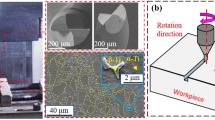Abstract
The top burr is the common problem that faced in micro milling and presents the significant effect on the machining quality. The top burr minimization is desired to achieve high precision machining in micro milling. In this paper, the top burr formation mechanisms are analyzed, and then micro milling experiments are conducted to investigate the effect of machining parameters on the morphology and size of top burr. It is found that the top burr formation is caused by the unexpected material plastic side flow at the top side, which is an unresisted free surface with low support stiffness during micro milling. The unseparated chips that are connecting on the top side greatly increase top burr. The optimal machining strategies are suggested to minimize top burr.












Similar content being viewed by others
Data availability
All data supporting the results of this article are presented in the article.
References
Jain VK, Sidpara A, Balasubramaniam R, Lodha GS, Dhamgaye VP (2014) Micromanufacturing: a review-part I. Proc Inst Mech Eng B J Eng Manuf 228:1–22
Jain VK, Dixit US, Paul CP, Kumar A (2014) Micromanufacturing: a review-part II. Proc Inst Mech Eng B J Eng Manuf 228:995–1014
Chen N, Li HN, Wu J, Li Z, Li L, Liu G, He N (2021) Advances in micro milling: from tool fabrication to process outcomes. Int J Mach Tools Manuf 160:103670
Suzuki H, Okada M, Fujii K, Matsui S, Yamagata Y (2013) Development of micro milling tool made of single crystalline diamond for ceramic cutting. CIRP Ann Manuf Technol 62:59–62
Boswell B, Islam MN, Davies J (2018) A review of micro-mechanical cutting. Int J Adv Manuf Technol 94:789–806
Wu X, Shen J, Jiang F, Wu H, Li L (2021) Study on the oxidation of WC-Co cemented carbide under different conditions. Int J Refract Met Hard Mater 94:105381
Oliveira FB, Rodrigues AR, Coelho RT, Coelho RT, Souza AF (2015) Size effect and minimum chip thickness in micromilling. Int J Mach Tools Manuf 89:39–54
Chen N, Li L, Wu J, Qian J, He N, Reynaerts D (2019) Research on the ploughing force in micro milling of soft-brittle crystals. Int J Mech Sci 155:315–322
Wu X, Li L, He N, Zhao M, Zhan ZZ (2015) Investigation on the influence of material microstructure on cutting force and bur formation in the micro cutting of copper. Int J Adv Manuf Technol 79:321–327
Auchi JC, Dornfeld D, Arrazola PJ, Franke V, Leitz L, Min S (2009) Burrs—analysis, control and removal. CIRP Ann 58:519–542
Kumar P, Kumar M, Bajpai V, Singh NK (2017) Recent advances in characterization, modeling and control of burr formation in micro-milling. Manufacturing Letters 13:1–5
International Standard ISO 13715 (2000) Technical Drawings-Edges of Undefined Shape-Vocabulary and Indications. International Organizationfor Standardization: Geneva, Switzerland
Gillespie A (1976) The formation and properties of machining burrs. J Manuf Sci Eng 98:66–74
Chern GL (2006) Experimental observation and analysis of burr formation mechanisms in face milling of aluminum alloys. Int J Mach Tools Manuf 46:1517–1525
Kiswanto G, Zariatin DL, Ko TJ (2014) The effect of spindle speed, feed-rate and machining time to the surface roughness and burr formation of Aluminum Alloy 1100 in micro-milling operation. J Manuf Process 16:435–450
Jang KI, Kim DY, Maeng S, Lee K, Han J, Seok J, Je TJ, Kang S (2012) Deburring microparts using a magnetorheological fluid. Int J Mach Tools Manuf 53:170–175
George M, Shreyes M (2012) Effect of process parameters on the rate of abrasive assisted brush deburring of microgrooves. Int J Mach Tools Manuf 57:46–54
George M, Shreyes M, David R (2013) Material removal during abrasive impregnated brush deburring of micromilled grooves in NiTi foils. Int J Mach Tools Manuf 72:37–49
Lekkala R, Bajpai V, Singh RK, Joshi SS (2011) Characterization and modeling of burr formation in micro-end milling. Precis Eng 35:625–637
Leticia C, Marcio B (2019) Investigation of burr formation and tool wear in micromilling operation of duplex stainless steel. Precis Eng 60:178–188
Wu X, Li L, He N (2017) Investigation on the burr formation mechanism in micro cutting. Precis Eng 47:191–196
Han J, Hao XQ, Li L, Liu LH, Chen N, Zhao GL, He N (2020) Investigation on surface quality and burr generation of high aspect ratio (HAR) micro-milled grooves. J Manuf Process 52:35–43
Zhang XW, Yu TB, Wang W, Zhao J (2019) Improved analytical prediction of burr formation in micro end milling. Int J Mech Sci 151:461–470
Kou Z, Wan Y, Cai YK, Liang XC, Liu ZQ (2015) Burr controlling in micro milling with supporting material method. Procedia Manufacturing 1:501–511
Pankaj K, Vivek B, Ramesh S (2017) Burr height prediction of Ti6Al4V in high speed micro-milling by mathematical modeling. Manufacturing Letters 11:12–16
Medeossi F, Sorgato M, Bruschi S, Savio E (2018) Novel method for burrs quantitative evaluation in micro-milling. Precis Eng 54:379–387
Dib MM, Duduch JG, Jasinevicius RG (2018) Minimum chip thickness determination by means of cutting force signal in micro endmilling. Precis Eng 51:244–262
Zou Z, Liu L, Li B, Deng W (2016) Research on burr formation mechanism in metal cutting with a backup material. Int J Adv Manuf Technol 86:1895–1907
Acknowledgements
The authors thank Ke Sun and Kai Zeng for providing the experiment guidance.
Code availability
Not applicable
Funding
This work was supported by National Natural Science Foundation of China (51905182) and Fundamental Research Funds for the Central Universities (ZQN-805).
Author information
Authors and Affiliations
Contributions
The authors who contributed to this work have been listed in the author information.
Corresponding author
Ethics declarations
Competing interests
The authors declare no competing interests.
Additional information
Publisher’s note
Springer Nature remains neutral with regard to jurisdictional claims in published maps and institutional affiliations.
Rights and permissions
About this article
Cite this article
Wu, X., Du, M., Shen, J. et al. Experimental research on the top burr formation in micro milling. Int J Adv Manuf Technol 117, 3477–3486 (2021). https://doi.org/10.1007/s00170-021-07916-4
Received:
Accepted:
Published:
Issue Date:
DOI: https://doi.org/10.1007/s00170-021-07916-4




